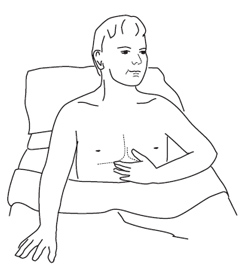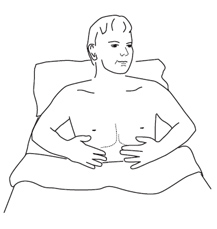It’s important to practice deep breathing and coughing after surgery. These exercises will help your breathing, clear your lungs, and lower your risk of pneumonia.
Breathe deeply and cough every hour while you’re awake for the first 2 to 3 days after minor surgery. It’s a good idea to continue these exercises until you return to your normal activities after your surgery. These exercises work better if you do them sitting up.
It’s also important to move and change your position often. These position changes help to make your breathing and coughing exercises work better.
Deep breathing exercises
Do these exercises every hour when you’re awake.

- Breathe in deeply and slowly through your nose, expanding your lower rib cage, and letting your abdomen (belly) move forward.
- Hold for a count of 3 to 5.
- Breathe out slowly and completely through pursed lips. Don’t force your breath out.
- Rest and repeat this 10 times every hour. Rest longer if you become dizzy or lightheaded.
Credit (Image): Alberta Hip and Knee Clinic 2019
Coughing exercises
It’s best to do coughing exercises when you’re feeling comfortable. Check with your healthcare provider to see if it's OK for you to do the coughing exercises in this handout.

- If you’re lying on your back, bend your knees, and rest your feet on the bed. Check with your healthcare provider first to see if it’s OK for you to bend your knees.
- Depending on the surgery you had, support your incision firmly with your hands or a small pillow before you try to cough.
- Breathe in deeply and cough firmly. If you cough up some mucous, clear it into a tissue. Repeat the coughing until there isn’t any more mucous. If you have a lot of mucous, you may need to take a break so you don’t get too tired.
Credit (Image): Alberta Hip and Knee Clinic 2019
Foot and leg exercises
Foot and leg exercises, also help you to get better sooner and prevent problems like blood clots. You may also have SCD stockings (Sequential Compression Devices) on your legs. These stockings inflate and deflate to keep good blood flow in your legs.
Do the exercises every hour while you’re awake.
Ankle pump
- Move your ankles up and down for 1 minute.
- Relax both feet.
- Repeat 5 times then relax.

Credit: Alberta Hip and Knee Clinic 2019
Ankle circles
- Move both ankles; first to the right, and then to the left.
- Repeat 5 times then relax.

Credit: Alberta Hip and Knee Clinic 2019
Heel slides
For this exercise, please check with your healthcare provider to make sure it’s OK for you to bend your knees.
- Bend each knee one at a time, sliding your foot up along the bed and then back down.
- Repeat 5 times then relax

Credit: Alberta Hip and Knee Clinic 2019 (adapted)
Changing positions
Change your position every hour while awake, or as directed by your nurse. It’s important to move often to prevent problems like a lung infection, blood clots, and weak muscles.
Walking
- For your safety, it’s important to have a nurse or physical therapist with you the first time you get up after your surgery. Remember to wear comfortable, nonslip footwear.
- At first you may need some help. As you become stronger, you’ll be able to move around more on your own. You may need to take short rests in between walks.
- It’s normal to feel dizzy and uncomfortable when you first get up. Move slowly and if you have too much pain or dizziness, tell your nurse or physical therapist.
- The goal is to be able to walk in the hall or in your home several times a day.
If you have any questions about these exercises, please ask your physical therapist or nurse.
